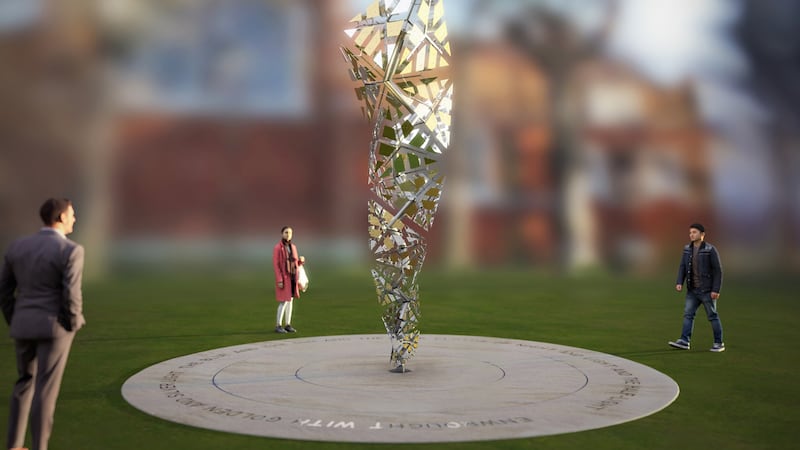It’s a surprising fact that the only poet brought up in England to win the Nobel Prize in Literature has no monument anywhere in England – anywhere in the UK in fact.
It is less surprising when you recall that poet is WB Yeats who, despite spending most of his youth, from age two, in London, and living there until he was 57, went on to become Ireland’s national poet, with his thoughts on England and Ireland becoming a complex mirror of his times, and those we live in now.
Until now the quiet, Queen-Anne-retro, Arts-&-Crafts-style conservation-area and architectural-history gem that is Bedford Park, where Yeats was raised, hasn’t considered celebrating the Irish poet whose genius it fostered.

Some years ago English Heritage suggested placing a blue plaque on the Blenheim Road, Chiswick, house where Yeats, in his twenties, wrote The Lake Isle of Innisfree, met Maud Gonne, co-founded the Irish Literary Society and wrote, at a neighbour’s request, his first staged play.
The plaque idea was panned, however, with one Bedford Park resident pointing out that “the old chap”, John Butler Yeats, a much-loved conversationalist but not entirely successful portrait painter, “was always behind with his rent”.
They have long memories here: and the remark echoes James Joyce’s observation that an Englishman’s proudest boast was that he’d always paid his way.
So what has changed to make local residents campaign for an artwork to celebrate Yeats in Bedford Park? Especially an artwork as striking, uplifting, dazzling, in its envisioning of Yeats’s swirling, gyring genius and of Bedford Park’s centrifugal, aspirational ideas, as Conrad Shawcross’s Enwrought Light in the image above?
And why would 200 or so local residents choose to fund a project celebrating – in their midst – Ireland's literary genius and his role in its cultural revival? That is along with artists, poets, actors, academics, Yeatsians etc from Britain, Ireland and the US, and supporters including Marie Heaney, Roy Foster, Ciaran Hinds, Polly Devlin, Fergal Keane and many more whom you can join by pledging to back the project here.
The answer is also the answer to the slur about the unpaid rent, which was in fact untypical of the Bedford Park of the 1890s and equally of today’s Bedford Park – a place which, in the latter half of the 20th century, had increasingly thought of itself as a quietly pleasant London suburb with some impressive architectural features.
A Bedford Park that had seemingly forgotten its role as a progressive, egalitarian, aesthetic, feminist/suffragist, Theosophite, Transcendentalist, multi-cultural, cosmopolitan, anti-imperial, anti-colonial and even vaguely anarchist hive, hub and crucible for all the 20th century’s great intellecual ideas, all its advances, the sort of place for creatives such as the Yeatses and their many friends and artist acquaintences, as Bedford Park, and Chiswick generally, are increasingly regarded as a creative centre and cultural quarter today.
John Butler Yeats, from Co Down, and Susan Pollexfen Yeats, from Sligo, brought their children to a Victorian, industrial London of steep, dark houses, so Yeats Snr was delighted when he heard from artist friends that Dublin-born Jonathan Carr was building a new Arts-&-Crafts village near the Thames designed for “communal happiness”: the first “garden suburb” ever, though much copied around the world, it had its own inn, stores, church, school of art and social club – to which men and women were, uniquely for 19th-century London, admitted equally.
And the company they were to find there over the years, Ukrainian anarchists, a Virginian abolitionist, Irish historians, French Impressionists, Roger Casement, occasionally, small-press publishers, actors and set-designers, Icelandic scholars, Britian’s second-ever Asian MP, as well as Fabians, spiritual seekers, Irish and Indian Home Rulers and a descendant of Pocahantas, created between them a fizzingly ideas-driven artist’s colony and Bohemian/Utopian near-commune in which the young WB Yeats became not merely a poet and dramatist but developed, for a former London schoolboy, an Irish nationalism that was foreign both to his Sligo Anglo-Irish upbringing and to his peers in London and Dublin gentlemen’s clubs.
Or, as Bob Geldof recently put it, promoting our artwork project: “Bedford Park is where the national poet understood what it was to be impoverished, alien, exiled, became obsessed with a woman who would haunt his life and give rise to the greatest poetry of the 20th century. Surrounded by his extraordinary family and his radically revolutionary neighbours, Bedford Park whipped the beautiful young poet into the maelstrom of poetry that would give rise to a nation.”

It is the Bedford Park of ideas – as much as of architecture – that a new generation of residents has set out to celebrate, with no more striking proof of the benefits of the “communal happiness” principle than the world-wide success of the lanky, dreamy schoolkid who stood “in the roadway” or “on the pavements grey” beside where Conrad Shawcross’s artwork will stand by Yeats’s birthday next year!
Finding an artist to capture that combination of poetic genius and spirit of place, of inspiring and aspiring atmosphere and ambience, proved, in the end, rather simple: London’s leading international artist in the public artworks sphere is clearly Conrad Shawcross, a perfect fit, a young London visual artist from a literary family (his mother Marina Warner lectures at this year’s Yeats Summer School in Sligo) to create his tribute to a young London literary artist from a family of visual artists.
Shawcross had spent some time re-reading Yeats, visiting Bedford Park and talking to local residents with an increasing sense of the Arts-&-Crafts movement’s desire to make aesthetics an everyday experience, leading him to focus especially on Yeats’s He Wishes for the Cloths of Heaven, of which he says:
“At the project’s 2018 launch at London’s Irish Embassy in Grosvenor Place, it was a reading of that particular poem by the incredible Ciarán Hinds that drew my attention to these particular lines:
Enwrought with golden and silver light,
The blue and the dim and the dark cloths
Of night and light and the half light…
“The rich physical description of material and the sense of time through evolution of light were really potent images for me, and led directly to the proposed work, which is not only ‘enwrought with’, or made from, ‘golden and silver light’, but also, although static, will be transformed throughout the day and night, through seasons, by ever-changing weather, and by the arcing position of sun and moon in ‘the heavens’.”
For some, Shawcross’s 4.5m high artwork represents a swirl of golden autumn leaves in Bedford Park’s tree-lined groves, a flock of the white birds that appear in Yeats’s work, a flight of the angels that crop up in Yeats’s Bedford Park-period poems (as well as adorning the cover and frontispiece of his 1895 Poems) and which just happen to be the dedicatees of St Michael and All Angels, the Yeats family’s parish church from 1879 to 1902 with occasional gaps, which stands behind Shawcross’s helical, tetrahedral swirl.
The artwork itself has received a £25,000 Royal Academy award which has helped the fund reach £105,000 so far (out of a £135,000 target), with support from the Irish Embassy, which sees the Yeats tribute as marking a particularly significant entwining of British and Irish cultural strands and as validating London-Irish and Irish-heritage cultural status. Hounslow Borough’s Thriving Communities fund has also supported the project’s role in creating community cohesion through shared cultural heritage and honouring migrant familes’ contribution to our shared culture.
Quite a dramatic change from a London conservation area that once viewed a family of world-renowned Irish artists as irrelevant to its place in history!











